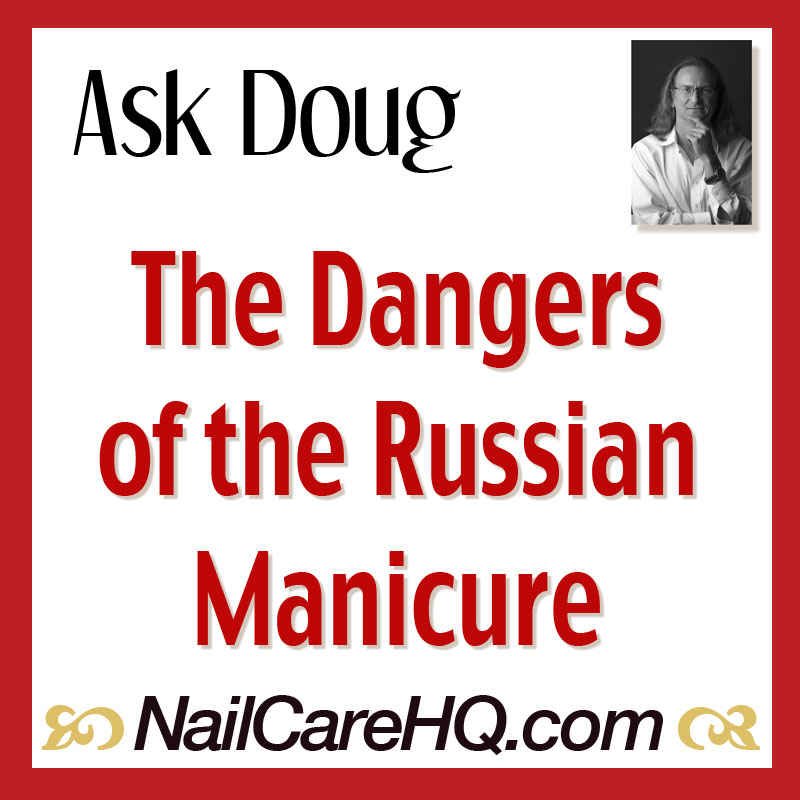RUSSIAN MANICURE
Excerpt from Face-to-Face with Doug Schoon, Volume II
Available on Amazon and iTunes- July 2017
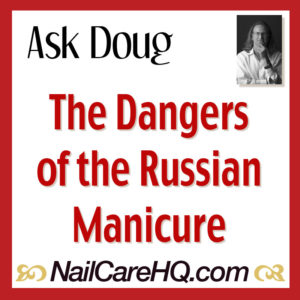
In this article, I’ll explain what a Russian Manicure is and why you never want one if your nail professional doesn’t have the correct training and appropriate license.
Since knowledge is power, I’ll also give you tips to help you become a better consumer when visiting a salon.
What Is It?
Some people around the globe are teaching a highly risky technique that goes by several different names including, the “Russian” or “Equipment” or “E-File” manicure.
It doesn’t matter what it’s called, they are essentially the same.
The process is to use an electronic file with very fine bits to file off the living skin around the nail plate. They also file off the dead cuticle skin on the nail plate.
The skin that everyone incorrectly thinks is the cuticle is called the proximal fold of the eponychium.
The proximal fold, lateral side walls, and the hyponychium create the 4 required guardian seals to protect the nail bed and matrix from harmful germs and bacteria.
We never want to cut or sand down live skin!
I believe the Russian manicure techniques are a potential threat to the entire nail industry.
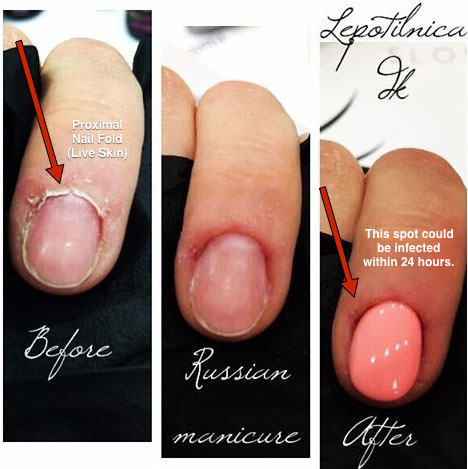 Here’s Why
Here’s Why
These are procedures that can be “invasive” and they promote the intentional cutting and/or abrasion of the living skin surrounding the nail plate.
Those who teach these Russian manicure techniques don’t use the term “abrasion.” Instead, they use nicer marketing terms like “buffing” or “polishing.”
Also, they claim to be removing pterygium, which would be incorrect. The pterygium is on the underside of the nail tip.
What these nail technicians are doing is removing the skin from the proximal nail fold and side walls.
To claim that the “nails look prettier” in my view is a poor reason to jeopardize a client’s health when safer ways to perform a manicure exist.
Cutting/abrading damages the skin and creates the very problem manicures are supposed to solve.
The result is more damaged skin that later must be cut or abraded away. It’s like a dog chasing its own tail!
Many people report the skin around the nail plate grows back thicker after the Russian manicure, so the nail tech needs to continue the method regularly, just to keep up.
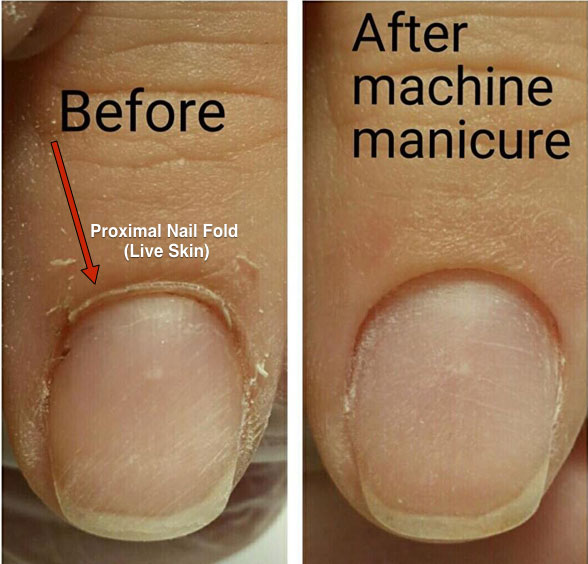 The Crushing Danger
The Crushing Danger
Nail salons are already under intense scrutiny and don’t need the media or salon-bashing activist groups using this as another reason to avoid salons.
This is a troubling concern.
Many people will be frightened by such techniques. This will make more people afraid of nail technicians and their services rather than enjoy the many positive benefits that salons offer.
Some nail techs justify their actions by claiming to use only sterile or disposable implements. They naively believe this prevents infections. Wrong!
Whenever the living skin is cut or abraded, the damaged area is more susceptible to infection for many hours or even days. The potential risk of infection will remain until the body heals.
One proponent of these methods argued to me, “I’ve never heard of that happening.”
Well, of course not!
Not many people would openly admit they cut a client’s skin and caused an infection.
Schools and teachers who promote these methods don’t check back with their students on a regular basis, so how could they know about when the methods they teach are being misused?
I’ve seen these types of nail tech inflicted infections occur many times.
Also, when this thin skin is damaged, it becomes more susceptible to irritation and may lead to permanent allergic reactions to nail coating products.
How?
Many people who use this nail preparation technique place nail coating products directly onto or up against the damaged skin. This also drastically increases the client’s risk for adverse skin reactions.
Some teachers say the bits are not abrasive and are smooth. Think about it. If they were not abrading the skin, then they would have no effect.
It is true that these bits may be less abrasive than the bits uses to file down acrylic nail enhancements.
But, any bit spinning at thousands of RPM and placed against the skin surface will abrade the skin.
This abrasion can reduce the skin’s effectiveness as a germ and bacteria barrier. It also makes it easier for infections and adverse skin reactions to occur.
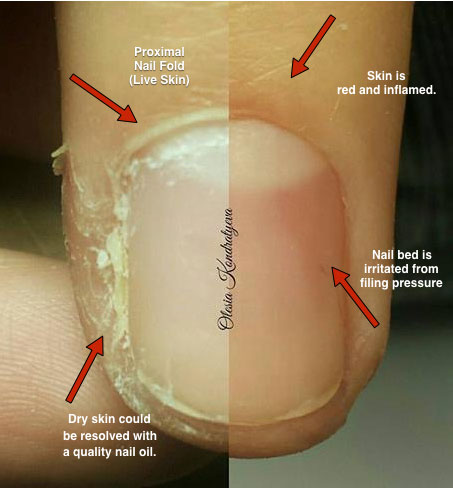 Fools Rush in Where Angels Fear to Tread
Fools Rush in Where Angels Fear to Tread
Another person asked me, “if it’s such a risk, why are so many doing it?
Just because some people do this technique doesn’t mean it’s safe.
This method should NOT be taught to the masses via Internet videos or online classes. Yet this is what’s being done weekly.
Too many people are “jumping on the bandwagon” without considering the consequences to their clients or their business.
Nor do I think so-called Russian manicure certification classes are the answer.
Many students of these courses often disregard important precautions and will return to the salon and do it “their way.” Then they will teach other nail technicians “their way” and those nail technicians will also do it “their way.”
Soon, the precautions will be forgotten and this could have unforeseen consequences that could harm clients and may be disastrous for the reputation of the nail industry.
Interestingly, many people who do these services claim they do it the safe way and others do not. Isn’t that the “pot calling the kettle black?”
Are You Licensed?
Even more importantly, using an e-file to smooth this skin is considered microdermabrasion. In many regions, microdermabrasion is restricted only to those with special licenses beyond nail technician licensing.
For instance, in the USA an esthetician license (or sometimes a cosmetology license) is required to perform microdermabrasion.
Ready To Fall?
I can walk on a rope that is one inch from the ground. I won’t get hurt if I fall.
But what if I try to walk on the same rope five feet above the ground? I could get seriously injured!
An expert tightrope walker doesn’t worry about falling from five feet—they are experts.
The low rope allows a lot of room for error for non-experts, while the high rope allows “little room for error”.
When high-speed bits are used and manicures become motorized, this allows little room for error.
The skin around the nails is nothing like that on the palm of the hand or bottom of the foot. It is much thinner and easier to damage.
Besides, even calluses should not be filed smooth, since this also increases the risks of infections. A protective layer of callus should always be left behind.
Some e-file experts do understand how to prevent injuries. But this is not such an easy thing to teach to non-experts, especially after just a few hours of instruction (or even a few days), which is what most classes offer.
In Conclusion
NEVER intentionally cut or abrade the skin around the nail plate. That’s trouble waiting to happen!

Doug Schoon, Author of Nail Structure and Product Chemistry
NEVER place any nail coating product directly against the skin, especially damaged skin!
This is, even more, trouble waiting to happen. It increases the risks of skin irritation and permanent allergies to these products.
Better Solutions
Protect and pamper the skin around your client’s nails—don’t invade it.
Teach them that their dry skin can be hydrated with a high-quality nail oil blend. It’s a simple and non-invasive solution.
Continue using the appropriate methods to properly remove the cuticle.
Explain to your clients and friends why they should avoid this Russian manicure technique as well.
We need you to help spread the word. Thank you! ~Doug Schoon
For more critically important advice about nail care, order Face-to-Face with Doug Schoon, Volume II, available on Amazon and iTunes- July 2017
